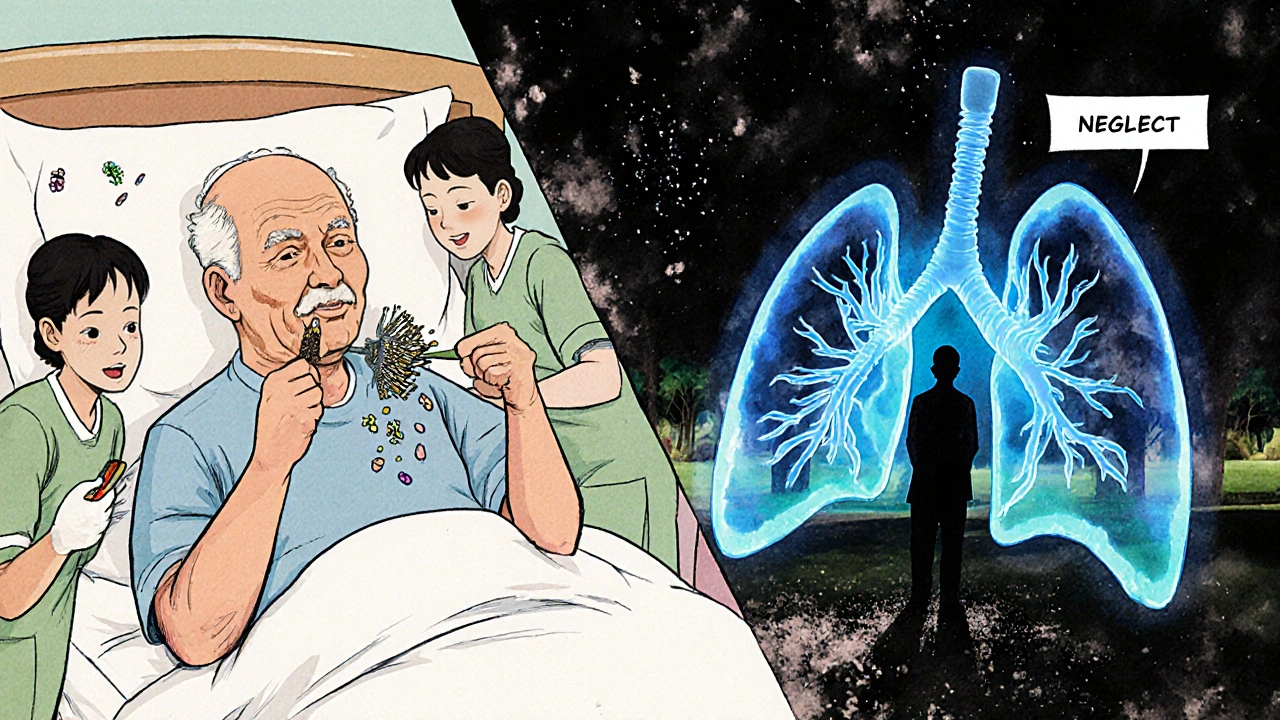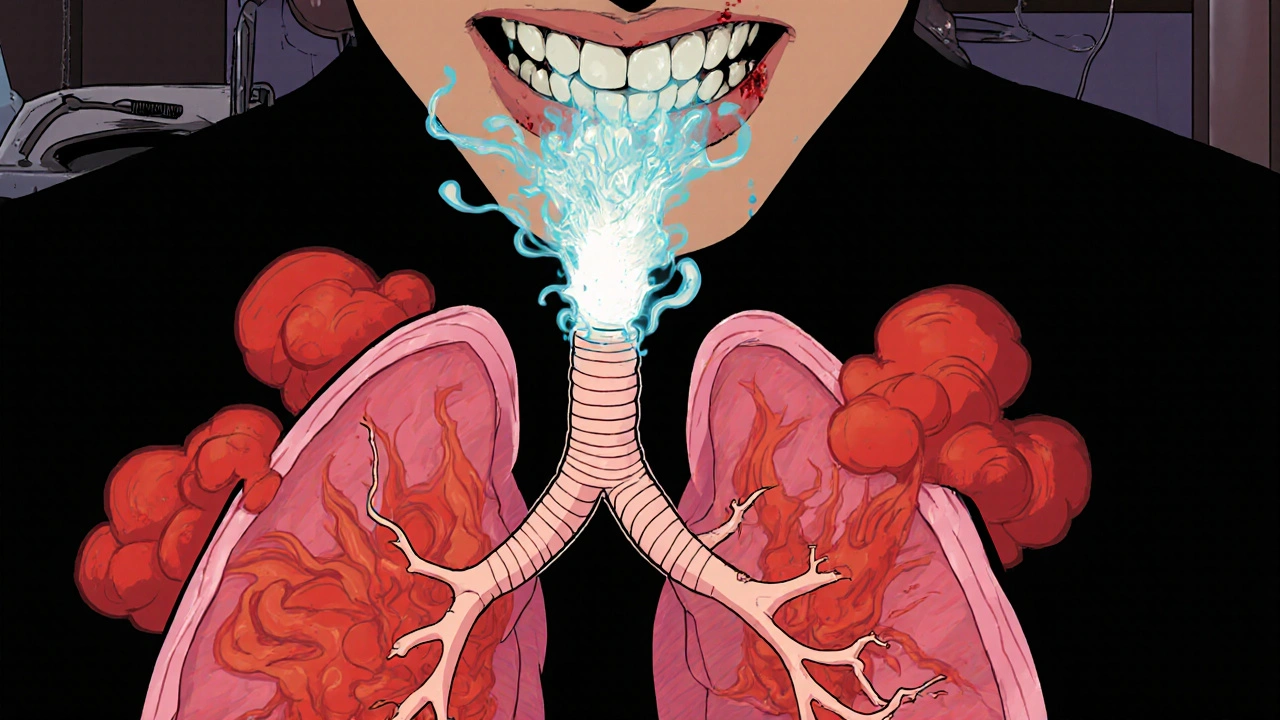Most people know brushing and flossing keep teeth clean and breath fresh. But few realize that skipping those habits can quietly invite bacteria into the lungs-leading to serious inflammation and even pneumonia. If you’ve ever had a lingering cough after a cold, or been told your pneumonia came out of nowhere, your mouth might be the hidden source.
The Mouth Is a Gateway to the Lungs
Your mouth isn’t just a place for chewing and speaking. It’s home to over 700 types of bacteria. Normally, your immune system keeps them in check. But when plaque builds up from poor brushing, those bacteria multiply-and some of them don’t stay put. Every time you swallow, cough, or even breathe deeply, tiny droplets from your mouth can travel down your windpipe. In healthy people, this isn’t a problem. But for older adults, smokers, or anyone with weakened immunity, those bacteria can settle in the lungs and trigger inflammation.
A 2023 study in the Journal of Clinical Periodontology followed 1,200 adults over age 65 for two years. Those with moderate to severe gum disease had a 37% higher chance of developing pneumonia than those with healthy gums. The bacteria linked to periodontitis-like Porphyromonas gingivalis and Fusobacterium nucleatum-were found in lung tissue samples from patients with bacterial pneumonia. These aren’t random invaders. They’re the same bugs that cause swollen, bleeding gums.
How Gum Disease Turns Into Lung Inflammation
It’s not magic. It’s mechanics. When plaque isn’t removed daily, it hardens into tartar. That creates deep pockets between teeth and gums where bacteria hide. These pockets bleed easily. Even minor bleeding lets bacteria enter the bloodstream. From there, they can travel anywhere-including the lungs.
Once in the lungs, these bacteria don’t just sit still. They trigger an immune response. White blood cells rush in, causing swelling, mucus buildup, and fluid accumulation. That’s inflammation. In healthy lungs, this clears up quickly. But in people with COPD, asthma, or a history of smoking, the lungs can’t recover as easily. The inflammation lingers, leading to chronic bronchitis, worsening COPD, or recurrent pneumonia.
One real-world example: a 72-year-old woman in Vancouver was hospitalized three times in 18 months with pneumonia. She had no known exposure to sick people, no recent travel, and no other risk factors. Her dentist found severe periodontitis. After deep cleaning and daily flossing, her lung infections stopped. Her doctor called it a "mouth-to-lung connection"-a term now used in pulmonology clinics across Canada.
Who’s at the Highest Risk?
Not everyone with bad breath will get pneumonia. But certain groups are far more vulnerable:
- Older adults over 65: Immune systems weaken with age. Saliva production drops, making it harder to wash away bacteria.
- People with chronic lung diseases: COPD, asthma, and bronchiectasis patients have damaged airways that trap bacteria more easily.
- Smokers: Smoking kills cilia-the tiny hairs in your lungs that sweep out germs. It also dries out the mouth, letting bacteria thrive.
- Diabetics: High blood sugar feeds bacteria and impairs healing. Gum disease is three times more common in diabetics.
- Nursing home residents: Limited mobility, poor access to dental care, and frequent antibiotic use create a perfect storm for oral bacteria to spread.
According to the Canadian Dental Association, over 50% of adults over 65 have untreated gum disease. And nearly 30% of pneumonia cases in long-term care facilities are linked to poor oral hygiene. That’s not just a dental problem-it’s a public health issue.

What You Can Do to Protect Your Lungs
The good news? You don’t need fancy tools or expensive treatments. Just three simple habits can cut your risk dramatically.
- Brush twice a day with fluoride toothpaste. Don’t just brush your teeth-brush your tongue and gums too. Bacteria hide under the gumline. A soft-bristled toothbrush and gentle circular motions work better than aggressive scrubbing.
- Floss daily. Brushing alone removes only 60% of plaque. Flossing gets the rest. If traditional floss is hard to use, try a water flosser. Studies show they reduce gum bleeding by 50% in just four weeks.
- Visit your dentist every six months. Even if your teeth don’t hurt, get a cleaning. Dentists can spot early gum disease before it spreads. Professional cleanings remove tartar that brushing can’t touch.
Some people think dental visits are optional if they’re not in pain. That’s a myth. Gum disease is silent until it’s advanced. By then, the damage to your lungs may already be done.
What Dentists Are Doing Differently Now
More dental offices are working with respiratory specialists. In British Columbia, some clinics now screen patients over 60 for lung disease risk based on their gum health. They use a simple tool: the Periodontal Screening Index. If scores are high, they send a note to the patient’s doctor recommending a chest X-ray or lung function test.
Hospitals in Toronto and Montreal now include oral hygiene in their pneumonia prevention protocols. Before surgery, patients get a dental checkup. In ICUs, nurses brush patients’ teeth twice a day-even if they’re unconscious. Why? Because intubated patients have a 60% higher risk of ventilator-associated pneumonia if their mouths aren’t cleaned. Simple tooth brushing cuts that risk by nearly half.

Myths That Put Your Lungs at Risk
There are a lot of false beliefs about oral health and lungs:
- "Mouthwash alone is enough." No. Antiseptic rinses reduce bacteria temporarily, but they don’t remove plaque. Plaque is sticky. You need mechanical cleaning-brushing and flossing.
- "I don’t have cavities, so my gums are fine." Cavities and gum disease are different problems. You can have perfect teeth and severe gum inflammation.
- "Only old people need to worry." Lung inflammation from oral bacteria can happen at any age. A 2024 study found that adults under 40 with untreated gum disease had a 2.5x higher risk of bacterial pneumonia than peers with healthy gums.
Don’t wait for symptoms. If your gums bleed when you brush, if your breath stays bad even after brushing, or if your teeth feel loose-see a dentist. These aren’t just "dental issues." They’re warning signs your lungs might be next.
What Happens If You Ignore It?
Ignoring poor oral hygiene doesn’t just mean losing teeth. It means inviting infection into your lungs. Repeated lung inflammation leads to scarring. Scarring means less oxygen exchange. Less oxygen means fatigue, shortness of breath, and a slower recovery from every cold or flu.
For people with existing lung conditions, it’s worse. A 2025 review in the European Respiratory Journal found that COPD patients with gum disease had 40% more hospital visits and 50% longer stays than those with healthy gums. Their lung function declined twice as fast.
This isn’t theoretical. It’s happening right now-in clinics, hospitals, and homes across Canada. And it’s preventable.
Can poor oral hygiene really cause pneumonia?
Yes. Bacteria from gum disease can travel from the mouth to the lungs, especially in people with weakened immunity. Studies have found the same strains of oral bacteria in lung tissue of pneumonia patients. This link is now recognized by major medical associations, including the American Heart Association and the Canadian Lung Association.
How often should I see a dentist to prevent lung problems?
Every six months is the standard recommendation. But if you’re over 65, have diabetes, smoke, or have a chronic lung condition, your dentist may suggest visits every three to four months. Regular cleanings remove tartar and catch early gum disease before it spreads.
Does using mouthwash replace brushing and flossing?
No. Mouthwash kills bacteria temporarily but doesn’t remove plaque-the sticky film that causes gum disease. Only brushing and flossing physically remove plaque. Use mouthwash as a supplement, not a replacement.
Can improving oral hygiene help someone already diagnosed with lung inflammation?
Yes. Studies show that treating gum disease in patients with COPD or pneumonia leads to fewer flare-ups and shorter hospital stays. Cleaning your mouth reduces the bacterial load your lungs have to fight. It’s not a cure, but it’s a powerful support tool.
Are electric toothbrushes better for preventing lung inflammation?
They’re more effective at removing plaque than manual brushes, especially for people with limited dexterity. A 2023 meta-analysis found electric toothbrushes reduced gum inflammation by 21% more than manual brushing over six months. But the key isn’t the brush-it’s consistency. Brushing well twice a day matters more than the type of brush.
If you want to protect your lungs, start by looking in the mirror. Do your gums bleed? Does your breath still smell bad after brushing? Those aren’t just dental red flags-they’re signals your lungs are under threat. Fix your mouth, and you might just save your breath.


9 Comments
People keep acting like this is some new revelation, but dentists and pulmonologists have been talking about this link for over a decade. If you’re over 60 and still skipping flossing because ‘my teeth don’t hurt,’ you’re playing Russian roulette with your lungs. This isn’t scare tactics-it’s biology. Brushing twice a day isn’t optional hygiene, it’s preventative medicine.
They’re using this to push dental insurance mandates and government control. Who funds these studies? Big Dentistry. They want you scared so you’ll pay for $800 cleanings every 3 months. My grandpa smoked for 50 years, never saw a dentist, and lived to 92. Coincidence? Maybe. Or maybe the real cause is Big Pharma hiding the truth about lung meds.
This is one of the most underreported public health stories of our time. The mouth isn’t just a gateway-it’s a highway for pathogens. That ‘mysterious’ pneumonia in older adults? More often than not, it’s a silent gum infection hitching a ride down the trachea. And the kicker? You don’t need fancy tech to stop it. Just a toothbrush, floss, and the discipline to use them. It’s not sexy, but it’s cheaper than ICU stays and saves more lives than half the new drugs on the market.
I used to think brushing was just for fresh breath, but my mom got pneumonia twice after her dental cleaning because she hadn’t flossed in years. Her doctor said it was likely from oral bacteria. Since she started flossing and using a water pick, she hasn’t had a single lung infection in 3 years. I know it sounds weird, but your mouth really is connected to your lungs. Don’t wait until you’re hospitalized to care. Just do it.
Let’s be real-this is just another liberal health narrative wrapped in medical jargon. If your lungs are failing, blame your poor lifestyle choices, not your gums. We’re being manipulated into overpaying for unnecessary dental procedures while real healthcare crises go ignored. Also, why is this only focused on Canada? Are we supposed to believe American lungs are immune to this? Ridiculous.
What fascinates me is how deeply interconnected our body systems are, yet we treat them in silos. The mouth is a mirror, not just a cavity of bacteria-it reflects systemic health. When I lived in Johannesburg, I saw elderly patients with advanced periodontitis and recurrent chest infections, and no one connected the dots until a nurse noticed their gums were always inflamed. It’s not about blame-it’s about awareness. We need to train nurses, doctors, and even caregivers to look at the mouth as part of respiratory care, not an afterthought. This isn’t just dentistry; it’s holistic medicine in its purest form.
OMG YES. 😭 I’m a dental hygienist and I see this ALL THE TIME. People come in saying ‘I don’t have cavities’ like that’s the only thing that matters. Your gums are screaming and you’re ignoring them? Your lungs are listening. Please, please, floss. Your future self will hug you. 💕
The empirical evidence presented in the referenced studies is compelling and aligns with emerging literature in the field of oral-systemic health. The mechanistic pathway-from plaque biofilm formation to microaspiration and subsequent pulmonary colonization-is biologically plausible and increasingly corroborated by microbiological sampling. It is imperative that interdisciplinary collaboration between dental and respiratory clinicians be formalized within primary care frameworks. I would welcome access to the Periodontal Screening Index protocol referenced; its potential for population-level risk stratification warrants further investigation.
Just brush. Floss. Go to the dentist. That’s it. No magic. No gadgets. No conspiracy. Just do the simple thing before it’s too late.
Write a comment